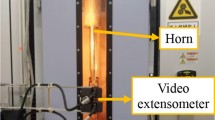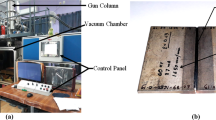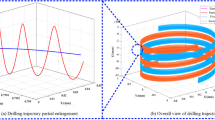Abstract
Poor-quality sheet sections and excessive burrs may be resolved by incorporating ultrasonic vibration into the shearing process of hard-to-deform magnesium alloy sheets. It is challenging to simulate the complicated mechanical process of ultrasonic shearing process because it involves material deterioration and fracture, elastic–plastic deformation of the material, and the impacts of ultrasonic indirect sexual contact. Relying on ABAQUS/Explicit finite element simulation software, this paper for the first time proposes a boundary constraint method of constructing a converter to connect displacement reference points and vibration reference points in order to perform numerical simulation of the ultrasonic shearing process of AZ31B magnesium alloy. The team’s ultrasonic vibration system serves as the basis for the simulation’s shearing model. This model utilizes three variables, namely sheet temperature, shear edge clearance, and ultrasonic amplitude, to analyze the weight coefficients and the influence law on the equivalent stress using the orthogonal test in order to further characterize the processing characteristics of ultrasonic shearing. This research demonstrates that numerical simulation is an effective method for examining the influence of process parameters on stress distribution. The results showed that in the ultrasonic shearing of AZ31B magnesium alloy sheet, the process parameter with the greatest influence on the weight coefficient was the sheet temperature, which was 49.8667, followed by the shear edge clearance, which was 31.2667, and the ultrasonic amplitude, which was 17.5333. When the sheet temperature is 150 ℃, the optimization effect is maximal, and the equivalent stress is reduced by 63.9 MPa. Under identical conditions, ultrasonic shearing substantially reduces the equivalent stress on the sheet compared to conventional shearing. During the ultrasonic shearing procedure, the equivalent stress of the sheet appears to be stress superposition and stress fluctuation, resulting in a significant improvement in sheet section quality. As a result, the paper can serve as a quantitative guide for predicting the ultrasonic shearing quality of the AZ31B magnesium alloy sheet.



















Similar content being viewed by others
References
Prasad SVS, Prasad SB, Verma K et al (2022) The role and significance of magnesium in modern day research-a review. J Magnes Alloys 10(1):1–61 ([CrossRef])
Meher A, Mahapatra MM, Samal P et al (2022) A review on manufacturability of magnesium matrix composites: processing, tribology, joining, and machining. CIRP J Manuf Sci Technol 39:134–158 ([CrossRef])
Liu B, Yang J, Zhang X, et al. (2023) Development and application of magnesium alloy parts for automotive OEMs: a review. J Magnes Alloys [CrossRef]
Song J, Chen J, Xiong X et al (2022) Research advances of magnesium and magnesium alloys worldwide in 2021. J Magnes Alloys 10(4):863–898 ([CrossRef])
Karnaukh SG, Markov OE, Aliieva LI et al (2020) Designing and researching of the equipment for cutting by breaking of rolled stock. Int J Adv Manuf Technol 109(9–12):2457–2464 ([CrossRef])
Sun W, Tan AWY, Marinescu I et al (2017) Adhesion, tribological and corrosion properties of cold-sprayed CoCrMo and Ti6Al4V coatings on 6061–T651 Al alloy. Surf Coat Technol 326:291–298 ([CrossRef])
Zheng Q, Zhuang X, Zhao Z (2019) State-of-the-art and future challenge in fine-blanking technology. Prod Eng Res Devel 13:61–70 ([CrossRef])
Scintilla LD, Tricarico L (2013) Experimental investigation on fiber and CO2 inert gas fusion cutting of AZ31 magnesium alloy sheets. Opt Laser Technol 46:42–52 ([CrossRef])
Fazily P, Yu J, Lee CW (2019) Characterization of sheared edges in warm blanking of magnesium alloy AZ31B. Materials 12(7):1023 ([CrossRef])
Liu K, Dong X, Shi W et al (2019) Investigation on two electrically-assisted forming processes of AZ31B magnesium alloy sheets. J Shanghai Jiaotong Univ (Science) 24:409–416 ([CrossRef])
Khalifa S S M (2020) An investigation of punching and mechanical properties of rolled AM60 and AZ61 magnesium alloys[D] [CrossRef]
Yang Z, Zhu L, Zhang G et al (2020) Review of ultrasonic vibration-assisted machining in advanced materials. Int J Mach Tools Manuf 156:103594 ([CrossRef])
Lotfi M, Amini S, Akbari J (2020) Surface integrity and microstructure changes in 3D elliptical ultrasonic assisted turning of Ti–6Al–4V: FEM and experimental examination. Tribol Int 151:106492 ([CrossRef])
Wen T, Wei L, Chen X et al (2011) Effects of ultrasonic vibration on plastic deformation of AZ31 during the tensile process. Int J Miner Metall Mater 18(1):70–76 ([CrossRef])
Yeh WC, Chu TS, Wang SS et al (2011) Finite element analysis of blanking process by superimposing ultrasonic vibrations[C]//Advanced Materials Research. Trans Tech Publications Ltd 201:126–132 ([CrossRef])
Liu Y, Cheng T, Hua L et al (2017) Research on the effect of ultrasonic vibration on the roll-over during the fine blanking process. J Mech Sci Technol 31:835–843 ([CrossRef])
Luo F, Sun F, Li K et al (2018) Ultrasonic assisted micro-shear punching of amorphous alloy. Mater Res Lett 6(10):545–551 ([CrossRef])
Xu Y, Gao F, Zou P et al (2020) Theoretical and experimental investigations of surface roughness, surface topography, and chip shape in ultrasonic vibration-assisted turning of Inconel 718. J Mech Sci Technol 34(9):3791 ([CrossRef])
Zhao X, Zhao D, Hu W et al (2021) Manufacturing of high-precision surface micro-structures on stainless steel by ultrasonic impact peening. Int J Adv Manuf Technol 116(3–4):915–930 ([CrossRef])
Chen G, Xu J, Wang J et al (2022) Numerical and experimental study on the amplitude effect of ultrasonic vibration-assisted milling of 3D needle-punched Cf/SiC composite. Ceram Int 48(12):17893–17914 ([CrossRef])
Liao J, Zeng X, Xue X (2022) Surface quality analysis of AZ31B Mg alloy sheet in ultrasonic-assisted warm single-point incremental forming. Int J Adv Manuf Technol 1–14 [CrossRef]
Patel VK, Bhole SD, Chen DL (2013) Ultrasonic spot welded AZ31 magnesium alloy: microstructure, texture, and lap shear strength. Mater Sci Eng, A 569:78–85 ([CrossRef])
Abootorabi Zarchi MM, Razfar MR, Abdullah A (2012) Investigation of the effect of cutting speed and vibration amplitude on cutting forces in ultrasonic-assisted milling. Proc Inst Mech Eng Part B: J Eng Manuf 226(7):1185–1191 ([CrossRef])
Cheng Z, Li Y, Li J et al (2022) Ultrasonic assisted incremental sheet forming: constitutive modeling and deformation analysis. J Mater Process Technol 299:117365 ([CrossRef])
Meng Y, Ma L, Jia W (2022) Experimental and simulation analysis of warm shearing process parameters for rolled AZ31B magnesium alloy plate. Crystals 12(5):661 ([CrossRef])
Johnson GR (1983) A constitutive model and data for materials subjected to large strains, high strain rates, and high temperatures. Proc. 7th Inf. Sympo. Ballistics 541–547 [CrossRef]
Feng F, Huang S, Meng Z et al (2014) A constitutive and fracture model for AZ31B magnesium alloy in the tensile state. Mater Sci Eng, A 594:334–343 ([CrossRef])
Hillerborg A, Modéer M, Petersson PE (1976) Analysis of crack formation and crack growth in concrete by means of fracture mechanics and finite elements. Cem Concr Res 6(6):773–781 ([CrossRef])
Chen G, Ren C, Zhang P et al (2013) Measurement and finite element simulation of micro-cutting temperatures of tool tip and workpiece. Int J Mach Tools Manuf 75:16–26 ([CrossRef])
Mabrouki T, Girardin F, Asad M et al (2008) Numerical and experimental study of dry cutting for an aeronautic aluminium alloy (A2024–T351). Int J Mach Tools Manuf 48(11):1187–1197 ([CrossRef])
Zhou Yaguo, Yan Zhifeng, Wang Zhongnan, LI Yonglian (2016) Fracture toughness of AZ31B alloy and temperature evolution during fracture. 45(8): 93–96 [CrossRef]
Yang Jieyan, Yuan Mingqing (2014) Research on plates shearing factors based on orthogonal experiment and finite element. Modern Machinery (1): 28–34 [CrossRef]
Funding
This work was supported by the National Natural Science Foundation of China (U1910213 and 52105388), Technological Innovation Talent Team Special Plan of Shanxi Province (202204051002002), Key Research and Development Program of Shanxi Province (202102050201005), and Program for the Innovative Talents of Higher Education Institutions of Shanxi, and Patent Promotion and Implementation Funding Research Project of Shanxi Province (No. 202303004).
Author information
Authors and Affiliations
Contributions
All authors contributed to the study conception and design. Investigation, methodology, simulation, data analysis, and writing were performed by Yue Meng. Supervision and reviewing were performed by Lifeng Ma, Weitao Jia, Hongbo Xie, and Liwei Lu. All authors read and approved the final manuscript.
Corresponding author
Ethics declarations
Ethics approval
Not applicable.
Consent to participate
The authors declare that all authors have read and approved to submit this manuscript to IJAMT.
Consent for publication
The authors declare that all authors agree to sign the transfer of copyright for the publisher to publish this article upon acceptance.
Competing interests
The authors declare no competing interests.
Additional information
Publisher's Note
Springer Nature remains neutral with regard to jurisdictional claims in published maps and institutional affiliations.
Rights and permissions
Springer Nature or its licensor (e.g. a society or other partner) holds exclusive rights to this article under a publishing agreement with the author(s) or other rightsholder(s); author self-archiving of the accepted manuscript version of this article is solely governed by the terms of such publishing agreement and applicable law.
About this article
Cite this article
Meng, Y., Ma, L., Jia, W. et al. Predictive assessment of the ultrasonic shearing quality of AZ31B magnesium alloy sheet based on coupled vibration-thermal model. Int J Adv Manuf Technol 128, 4913–4931 (2023). https://doi.org/10.1007/s00170-023-12225-z
Received:
Accepted:
Published:
Issue Date:
DOI: https://doi.org/10.1007/s00170-023-12225-z




